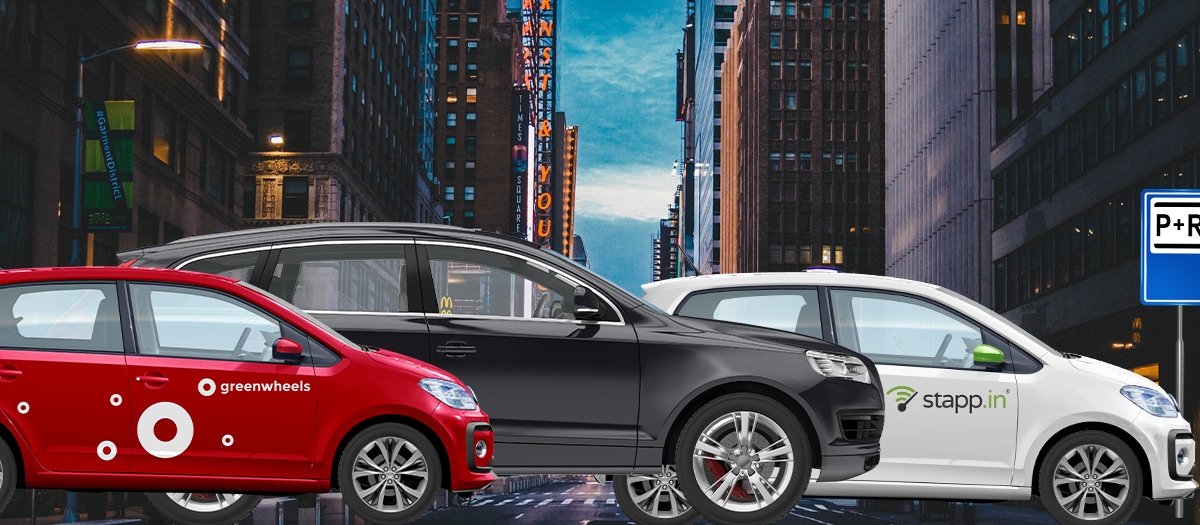Shared cars are one of the most promising solutions for making the mobility sector more sustainable. After all, owning your own means of transport is quite inefficient. Why own a car when it sits idle 95% of the time? Thanks to technological and digital advances, the use of shared cars is becoming more accessible, convenient and affordable.
Sharing is the new having; it is a general trend. In many areas we are shifting from owning to using. Twenty years ago we still had closets full of CDs or LPs, now the entire music world is at our feet thanks to Spotify. Twenty years ago we bought movies on DVD, now we surf to our heart’s content thanks to Netflix.
Mobility as a Service
Ook in mobiliteit is delen aan een sterke opmars bezig. Mobity as a service, of MaaS, heet dat dan. Autodelen wordt de nieuwe norm, voorspellen de geleerden van McKinsey, maar bijvoorbeeld ook het ministerie van Infrastructuur en Waterstaat. En dat moet ook, want autodelen is stukken duurzamer dan iedereen een eigen auto voor de deur. Onderzoek van het Planbureau voor de Leefomgeving laat zien dat autodelers 8 tot 13% minder CO2 uitstoten. Het bewuster gebruik van de auto komt ook de bereikbaarheid ten goede.Sharing is also making strong inroads in mobility. Mobity as a service, or MaaS, is the name of the game. Car sharing is becoming the new norm, predicts the scholars at McKinsey, but also the Ministry of Infrastructure and Water Management. And so it should, because car sharing is much more sustainable than everyone having their own car at the door. Research by the Netherlands Environmental Assessment Agency shows that car sharers emit 8 to 13% less CO2. The more conscious use of the car also benefits accessibility.
Green Deal Car Sharing
The Green Deal car sharing II, which was signed in 2018 by municipalities, provinces, leasing companies, shared car providers, Nature and Environment Foundation and the Ministry of Economic Affairs and Climate, set the goal of having 700 thousand shared car users by 2021. This target was already achieved in the spring of 2019, a year earlier than anticipated.
Share car versus own car
Sharing may be the new thing, but when it comes to mobility, there are still some bumps to overcome before we reach a unanimous embrace of the shared-car principle. For starters, the bump in accessibility. Whereas Spotify has increased access to music enormously, shared transport has so far had the intrinsic consequence of reducing the availability of a car. At least, if you compare it to having your own car in front of your door, which you can drive away with at any time without having to perform a number of actions on your mobile or computer first. After all, it remains to be seen whether there is a shared transport option available in the vicinity. And if there is, whether it is sufficiently charged and clean.
The costs
For many car owners, these downsides weigh so heavily that they don’t want to part with their “ride” just yet. The costs also weigh in. Of course, owning a car is expensive; you pay insurance and road tax, maintenance and fuel. But car ownership is getting cheaper thanks to private leasing. For people who often need a car and do not live in a neighborhood with high parking pressure and/or high parking rates, a private car is soon easier and perhaps even cheaper than relying entirely on shared cars. But of course, there are also plenty of people who don’t want or can’t own a car at all, or who only need one occasionally. For those people, shared cars, but also other forms of shared transportation, are a godsend. It is no coincidence that mobility sharing concepts are mushrooming.
Larger supply: more complexity
In the early years of car sharing, the main challenge was: how do we organize personal handover of the vehicle and/or access to the vehicle? Automated solutions with RFID readers emerged, eliminating the need for a physical key transfer. Thanks to the advent of smartphones and advances in mobile networks, shared transport became increasingly easy and accessible. Technological developments also brought about a growing variety of sharing concepts and business models. More and more types of shared vehicles are being added to the street scene, from cars to bicycles and mopeds to scooters. With the growing range and variety, the complexity is also increasing.
Need for simplicity
Not only the supply, but also the number of shared transport users is growing. As more people incorporate shared transportation into their daily existence, the expectations for the services surrounding this shared transportation also increase. The shared transport user does not want to operate twenty different apps to plan and book his trip from A to Z. He wants to be able to book his trip in one environment. He wants to arrange his shared transport trip in one environment, just like he arranges his music in Spotify. A reliable, clear, flexible and simple on-demand service for all available shared transport is a must.
One-stop shop for mobility
Mobility apps respond to that need by functioning as a one-stop shop for any form of (shared) mobility. Through an app like Gaiyo you can easily order a shared car or other form of shared transportation at any time. And soon, after you’ve ordered it, that shared car will probably also be driven to your front door in an autonomous manner.
Car sharing: the new normal
It is exactly these kinds of technological innovations that will ensure that the use of shared vehicles will become increasingly attractive and affordable worldwide, with the ultimate consequence that more and more people will get rid of their private cars in favor of more sustainable sharing alternatives.

